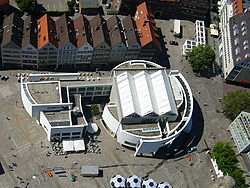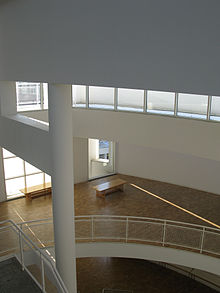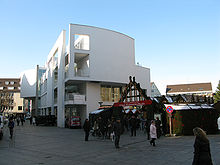Town house Ulm
 The town house from the tower of the Ulm Minster |
|
| Data | |
|---|---|
| place | Ulm |
| Art |
Exhibitions (art, architecture, contemporary history),
events, citizens' forum, tourist information , gastronomy |
| architect | Richard Meier |
| opening | November 12, 1993 |
| Number of visitors (annually) | approx. 200,000 (exhibitions, events) |
| operator |
City of Ulm
|
| management |
Karla Nieraad
|
| Website | |
| ISIL | DE-MUS-664317 |
The Ulm Stadthaus is the central building next to the Ulm Minster on Ulm Minster Square . It was designed by the New York architect Richard Meier .
location
The Münsterplatz is located in the center of the southern German city of Ulm . It is lined with many commercial buildings, most of which were built after the Second World War. The square is dominated by the town house, which with its white facade and modern architecture represents a clear contrast to the Gothic cathedral.
history
Barefoot monastery
For many centuries there was a monastery on the area of today's town hall. Construction began before 1250 (the foundation stone for the Ulm Minster was laid in 1377) and has been expanded again and again later. This barefoot monastery , adjoining the cathedral to the west, housed the city's highest educational institution after the Reformation with the Latin school (later grammar school or grammar school academicum).
In 1878, shortly before the church tower was completed, the barefoot monastery was demolished and the Münsterplatz "exposed". The goal was to have a clear view of the tallest church tower in the world. The now exposed square should immediately be built with a sophisticated architecture.
Empty on the Münsterplatz
Since then it has always seemed clear that Münsterplatz was too big, despite the high church tower. The redesign was still a long struggle. A total of 17 competitions are documented, the first in 1924 with 467 submitted designs.
In 1986 the majority rejected a new building in a referendum ; however, this did not reach the quorum and was therefore not binding for the city. Accordingly, the city council decided to build on Münsterplatz.
Monument protection
In 2019 the town house was placed under monument protection and received the status of a cultural monument of special importance.
Townhouse
In place of a pavilion, which had previously housed the tourist information , the so-called town house of the New York architect Richard Meier was to be built. It should be a "walk-in sculpture", space for exhibitions, concerts, conferences, lectures, etc., also contain the tourist information again and also gastronomy.
The townhouse opened in 1993. It remained controversial among the population for a long time, as in the eyes of many it did not fit in architecturally with the Gothic cathedral.
Today the town house fits into the architectural redesign of the entire area between Ulm City Hall and Münsterplatz, where a four-lane street has been replaced by numerous new buildings. The construction of the town house thus marks the beginning of the design of the so-called “New Center” in Ulm.
building
The white plastered town house, the structure of which arises from a cube-shaped geometry and concentric circles, is a three-story pavilion with an area of approx. 3,600 m². A good 2,000 m² of this are open to the public. A larger west wing and a smaller east wing are connected to one another via glazed bridges and a roof terrace. The openly merging exhibition areas, restaurants and shops are flooded with daylight. Glass facades, glass shed roofs, smaller and larger terraces, balconies and arcades provide a view of the Ulm Minster. Part of the townhouse is clad in Rosa Dante granite . The same stone is used on the terraces, balconies, for the stairs and some floors in the interior as well as for the entire Münsterplatz. With its pink tint it refers to the wall facade of the Ulm Minster. The almost 7-meter-high town hall offers space for up to 320 people, depending on the type of seating. The furnishings are variable and change almost daily. The hall is visibly connected to the exhibition area, the Münsterplatz and the Münster itself via wide glass surfaces. The high level of transparency between the indoor and outdoor areas is a trademark of the architect Richard Meier. The heart of the town house is the open staircase in the west wing, which opens up all areas and floors without access restrictions.
use
The town hall shows changing exhibitions of contemporary photography and art, here mainly outsider art , as well as on topics of architecture and contemporary history.
Most of the hall is rented out. Mostly public events on contemporary issues from the fields of politics, media, science, medicine, social affairs, economics, culture, etc. take place here almost every day. In addition, the town house has been hosting a themed festival of new music since 1996 . Since 2014 this has taken place biennially in spring.
The tourist information is located on the ground floor of the town hall, it is the contact point for visitors from all over the world. Ulm currently has around 7 million day tourists per year.
The catering in the town house and various commercial providers complete the offer.
Exhibitions (selection)
- 1996: Joseph Gallus Rittenberg : Stabat Mater. An oratorio for Ulm in 52 pictures
- 1998: Ed van der Elsken : Hong Kong
- 2000: Micha Bar-Am : Israel
- 2004: Albert Einstein . 1879-1955
- 2005/06: Bettina Flitner : Women with Visions. 48 European women
- 2007: Itty Neuhaus : Home for Haus
- 2008: The murderers are among us. The Ulm Einsatzgruppen Trial in 1958
- 2011: Take off - the vision of flying. For the Berblinger anniversary year
- 2011: Olaf Otto Becker : Northern Traces
- 2012: Hamideddine Bouali : Révolution à la tunisienne
- 2012: Jodi Bieber : Between Darkness and Light
- 2012: Karin Székessy
- 2012: Michael Wesely and Lina Kim : Brasília
- 2013: Jim Rakete : The State of Play
- 2014: Faces of War. Photos by Bryan Adams , Anja Niedringhaus , Jan Banning
- 2015: Between Myth and Ideology. Photographs from Abbas' life's work
- 2015: Alejandro Cegarra : The other side of the Torre de David
- 2016: On This Earth, A Shadow Falls Across The Ravaged Land. Photographs by Nick Brandt
- 2016: Timm Rautert : The Amish and Von der Sehnsucht nach Farbe. Classic Amish quilts from the Schlumberger Collection
- 2017: Pictures from North Korea. Photos by Nathalie Daoust , Reinhard Krause and Julia Leeb
- 2017: Herlinde Koelbl : My view. Works 1980–2016
- 2018: Martin Parr : Souvenir - A Photographic Journey
- 2018: Andy Spyra : The Robbed Girls. Boko Haram and the terror in the heart of Africa
literature
- Stephan Barthelmess, International Creative Management (Ed.): Richard Meier - Stadthaus Ulm . International Creative Management, Niederstotzingen 1993, ISBN 3-9803357-1-2
- Anja Göbel, Karla Nieraad, Katja Storr: Ulm City Hall . 2nd edition, Ulm 2005, ISBN 978-3-934727-06-9
- Hans-Eberhard Hess: Explaining the world . In: Photo International. The magazine for the international photo scene, Munich, 5/2017 (about the profile of the photography exhibitions in the Ulm town hall)
- Richard Meier: Town House Ulm. Edition Axel Menges 1995, ISBN 3-930698-09-9
- Richard Meier, EM Hallworth (transl.), Anke Zeppenfeld (transl.), Karla Nieraad (arr.): “The town house has a special place in my heart”: Comments on the town house in Ulm . Series: Edition Stadthaus, Vol. 1, Stadthaus, Ulm 2007, ISBN 978-3-934727-19-9
- Manfred Sack (text), Klaus Kinold (photos), Axel Menges (ed.), Michael Robinson (English translation): Richard Meier, Stadthaus Ulm . Series: Opus, Vol. 9, Ed. Menges, Stuttgart 1994, ISBN 3-930698-09-9
- Adolf Silberberger: Redesign of Ulm Minster Square . Süddeutsche Verlagsgesellschaft, Ulm 1993, ISBN 3-88294-195-2
- Max Stemshorn, Alexander Wetzig (Hrsg.): Münsterplatz, a European urban space in transition: Ulm Münsterplatz in the past and present . 2nd edition Süddeutsche Verlagsgesellschaft, Ulm 2005, ISBN 3-88294-358-0
- Manfred Sack: Luxury? Why not. In: Die Zeit , No. 47/1993
Web links
Individual evidence
- ↑ ulm.de ( Memento of the original from June 10, 2011 in the Internet Archive ) Info: The archive link was inserted automatically and has not yet been checked. Please check the original and archive link according to the instructions and then remove this notice. (PDF; 181 kB)
- ↑ ulm.de ( Memento of the original from April 7, 2010 in the Internet Archive ) Info: The archive link was inserted automatically and has not yet been checked. Please check the original and archive link according to the instructions and then remove this notice.
- ↑ bad-bad.de
- ↑ Ingrid Honold: The Ulmer Münsterplatz: Competitions and projects for its urban and architectural design . Dissertation Eberhard-Karls-Universität Tübingen, Institute for Architecture, Tübingen 1993.
- ↑ Town house on Ulmer Münsterplatz. In: arch INFORM ; Retrieved December 1, 2009.
- ↑ Will Ulm stay Ulm? In: Die Zeit , No. 39/1987, p. 59, on the referendum
- ^ City of Ulm (Ed.): Münsterplatz - Citizens' decision on September 20, 1987. Row: City of Ulm . Information, Ulm 1987
- ↑ A town house on Münsterplatz ?! . Town house Ulm. Retrieved April 30, 2017.
- ↑ https://bnn.de/nachrichten/suedwestecho/stadthaus-ulm-kulturdenkmal-von-besonderer-bedeutung
- ↑ Mirjam Roller: Discussions and acceptance of the redesign of the Ulm Münsterplatz. In: Blaubeurer geographical booklets 10. Denkhaus, Blaubeuren 1996, ISBN 3-930998-10-6 .
- ^ Mathias Schreiber: Meier's milk. Richard Meier's town house in Ulm, once the occasion of a civil revolt, will be inaugurated this week - construction sacrilege on the famous cathedral tower? In: Der Spiegel . No. 45 , 1993, pp. 246, 248 ( online ).
- ↑ Stadthaus Ulm: Press kit Stadthaus Ulm. Published for the opening of the town hall on November 12, 1993.
- ↑ Neue Musik im Stadthaus.Retrieved April 3, 2017.
- ^ Ulm town hall. Retrieved March 30, 2017 .
- ^ Ulm town hall. Retrieved August 15, 2017 .
- ↑ Stadthaus Ulm. Accessed March 30, 2017.
- ↑ Stadthaus Ulm. Accessed March 30, 2017.
- ^ Ulm town hall. Retrieved August 15, 2017 .
- ↑ Stadthaus Ulm. Accessed March 30, 2017
- ↑ Stadthaus Ulm. Accessed March 30, 2017.
- ↑ Stadthaus Ulm. Accessed March 30, 2017.
- ↑ Stadthaus Ulm. Accessed March 30, 2017.
- ↑ Stadthaus Ulm. Accessed March 30, 2017.
- ↑ Stadthaus Ulm. Accessed March 30, 2017.
- ^ Ulm town hall. Retrieved March 30, 2017 .


